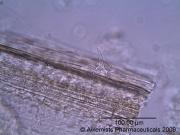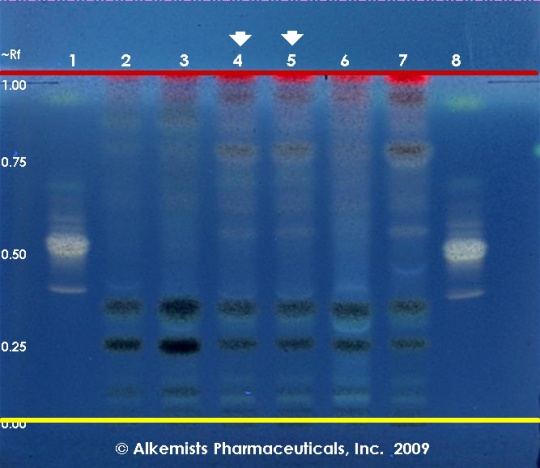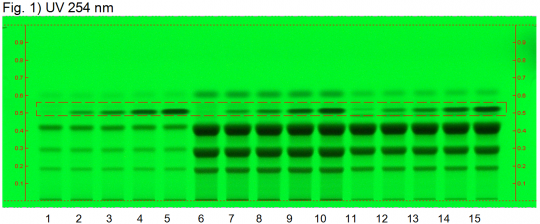Triticum aestivum (leaf)
(addition of hptlc info.--jd) |
|||
| Line 38: | Line 38: | ||
| reference= Method Developed by Alkemists Laboratories | | reference= Method Developed by Alkemists Laboratories | ||
| + | | }} | ||
| + | |||
| + | {{HPTLC | source=HPTLC Association | ||
| + | | companyimage=HPTLC-assoc-Logo-farbig-Text-schwarz-300x47.png | ||
| + | | companyURL=http://www.hptlc-association.org/ | ||
| + | | mainimage=Curcuma longa w nim-UV 254 nm-hptlc-association.png | ||
| + | | caption1=Turmeric adulteration with nimesulide (rhizome) HPTLC ID - UV 254 nm | ||
| + | | description=Turmeric adulteration with nimesulide (rhizome) (''Curcuma longa'') | ||
| + | | image2=Curcuma longa w nim-2,5-Dichloro-1,4-benzoquinone reagent, UV 366 nm-hptlc-association.png | ||
| + | | caption2=Turmeric adulteration with nimesulide (rhizome) HPTLC ID - 2,5-Dichloro-1,4-benzoquinone reagent, UV 366 nm | ||
| + | | image3=Curcuma longa w nim-2,5-Dichloro-1,4-benzoquinone reagent, white RT-hptlc-association.png | ||
| + | | caption3=Turmeric adulteration with nimesulide (rhizome) HPTLC ID - 2,5-Dichloro-1,4-benzoquinone reagent, white RT | ||
| + | | | ||
| + | | stationaryphase=Stationary phase, i.e. Silica gel 60, F254 | ||
| + | | mobilephase=Toluene, acetic acid (4:1) (v/v) | ||
| + | | prep=Sample: Mix 0.2 g of powdered sample with 3 mL of methanol, sonicate for 10 minutes, then centrifuge or filter the solution and use the supernatant/filtrate as test solution. | ||
| + | |||
| + | Derivatization reagent: 2,5-Dichloro-1,4-benzoquinone reagent, Preparation: 0.50 g of 2,5-Dichloro-1,4-benzoquinone is dissolved in 80 mL of dimethyl sulfoxide and then diluted with 160 mL of tetrahydrofuran, Use: Dip (time 0, speed 5), dry in a stream of cold air for 3 min. | ||
| + | | detection=Saturated chamber; developing distance 70 mm from lower edge; relative humidity 33% | ||
| + | | referencesamples=Reference: Dissolve 1.0 mg of nimesulide in 10 mL of methanol. | ||
| + | | | ||
| + | | lanes=Lanes, from left to right (Track, Volume, Sample): | ||
| + | # 2 µL Turmeric 1 (not spiked) | ||
| + | # 2 µL Turmeric 1 (spiked w/ 1% nimesulide) | ||
| + | # 2 µL Turmeric 1 (w/ 2% nimesulide) | ||
| + | # 2 µL Turmeric 1 (w/ 5% nimesulide) | ||
| + | # 2 µL Turmeric 1 (w/ 10% nimesulide) | ||
| + | # 2 µL Turmeric 2 (not spiked) | ||
| + | # 2 µL Turmeric 2 (w/ 1% nimesulide) | ||
| + | # 2 µL Turmeric 2 (w/ 2% nimesulide) | ||
| + | # 2 µL Turmeric 2 (w/ 5% nimesulide) | ||
| + | # 2 µL Turmeric 2 (w/ 10% nimesulide) | ||
| + | # 2 µL Turmeric 3 (not spiked) | ||
| + | # 2 µL Turmeric 3 (w/ 1% nimesulide) | ||
| + | # 2 µL Turmeric 3 (w/ 2% nimesulide) | ||
| + | # 2 µL Turmeric 3 (w/ 5% nimesulide) | ||
| + | # 2 µL Turmeric 3 ( w/ 10% nimesulide) | ||
| + | |||
| + | |||
| + | | notes=''Images presented in this entry are examples and are not intended to be used as basis for setting specifications for quality control purposes.'' | ||
| + | |||
| + | System suitability test: Nimesulide: Rf ~ 0.51 | ||
| + | |||
| + | Test for adulteration: Compare result with reference images. The fingerprint of the test solution is similar to that of the corresponding botanical reference sample. Additional weak zones may be present. The chromatogram of the test solution shows no zone at Rf ~ 0.51 corresponding in color and position to that of the nimesulide reference standard. | ||
| + | |||
| }} | | }} | ||
Revision as of 23:45, 24 June 2013
Contents |
Introduction
Macroscopic Entries
Microscopic Entries
|
HPTLC Entries
|
Wheat grass (grass) (Triticum aestivum) Lane Assignments Lanes, from left to right (Track, Volume, Sample):
Reference materials used here have been authenticated by macroscopic, microscopic &/or TLC studies according to the reference source cited below held at Alkemists Laboratories, Costa Mesa, CA. Stationary Phase Silica gel 60, F254, 10 x 10 cm HPTLC plates Mobile Phase chloroform: methanol: water [6.4/5/1] Sample Preparation Method 0.3 g + 3 ml CH3OH sonicated + heated @ 50° C ~ 1 hr Detection Method Vanillin/H2SO4 Reagent -> 110° C 5 min -> UV 365 nm Reference see Method Developed by Alkemists Laboratories
|
|
Turmeric adulteration with nimesulide (rhizome) (Curcuma longa) Lane Assignments Lanes, from left to right (Track, Volume, Sample):
Reference Sample(s) Reference: Dissolve 1.0 mg of nimesulide in 10 mL of methanol. Stationary Phase Stationary phase, i.e. Silica gel 60, F254 Mobile Phase Toluene, acetic acid (4:1) (v/v) Sample Preparation Method Sample: Mix 0.2 g of powdered sample with 3 mL of methanol, sonicate for 10 minutes, then centrifuge or filter the solution and use the supernatant/filtrate as test solution. Derivatization reagent: 2,5-Dichloro-1,4-benzoquinone reagent, Preparation: 0.50 g of 2,5-Dichloro-1,4-benzoquinone is dissolved in 80 mL of dimethyl sulfoxide and then diluted with 160 mL of tetrahydrofuran, Use: Dip (time 0, speed 5), dry in a stream of cold air for 3 min. Detection Method Saturated chamber; developing distance 70 mm from lower edge; relative humidity 33% Other Notes Images presented in this entry are examples and are not intended to be used as basis for setting specifications for quality control purposes. System suitability test: Nimesulide: Rf ~ 0.51 Test for adulteration: Compare result with reference images. The fingerprint of the test solution is similar to that of the corresponding botanical reference sample. Additional weak zones may be present. The chromatogram of the test solution shows no zone at Rf ~ 0.51 corresponding in color and position to that of the nimesulide reference standard. Source: HPTLC Association [3] |
Other Points of Interest
Cite error: <ref> tags exist, but no <references/> tag was found






